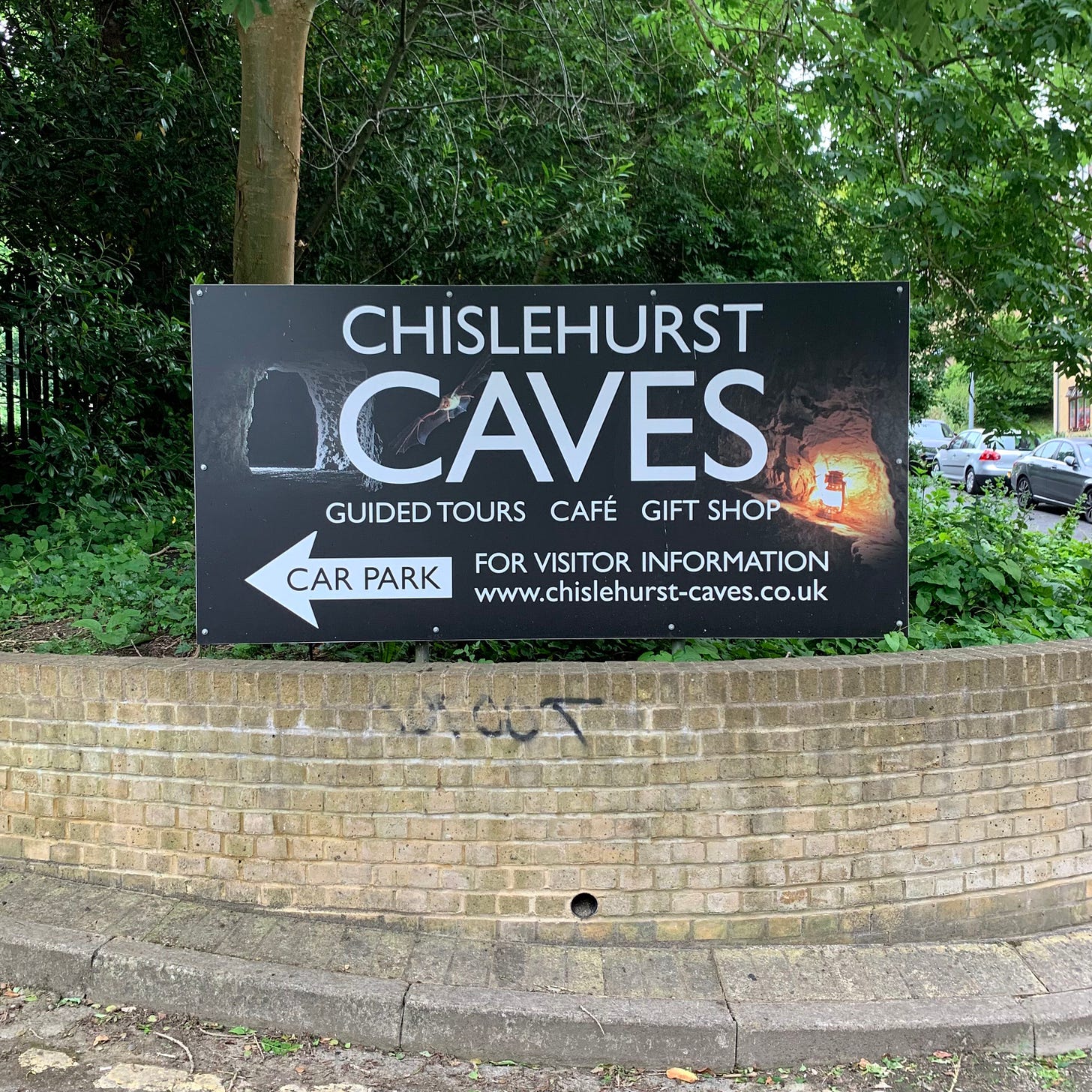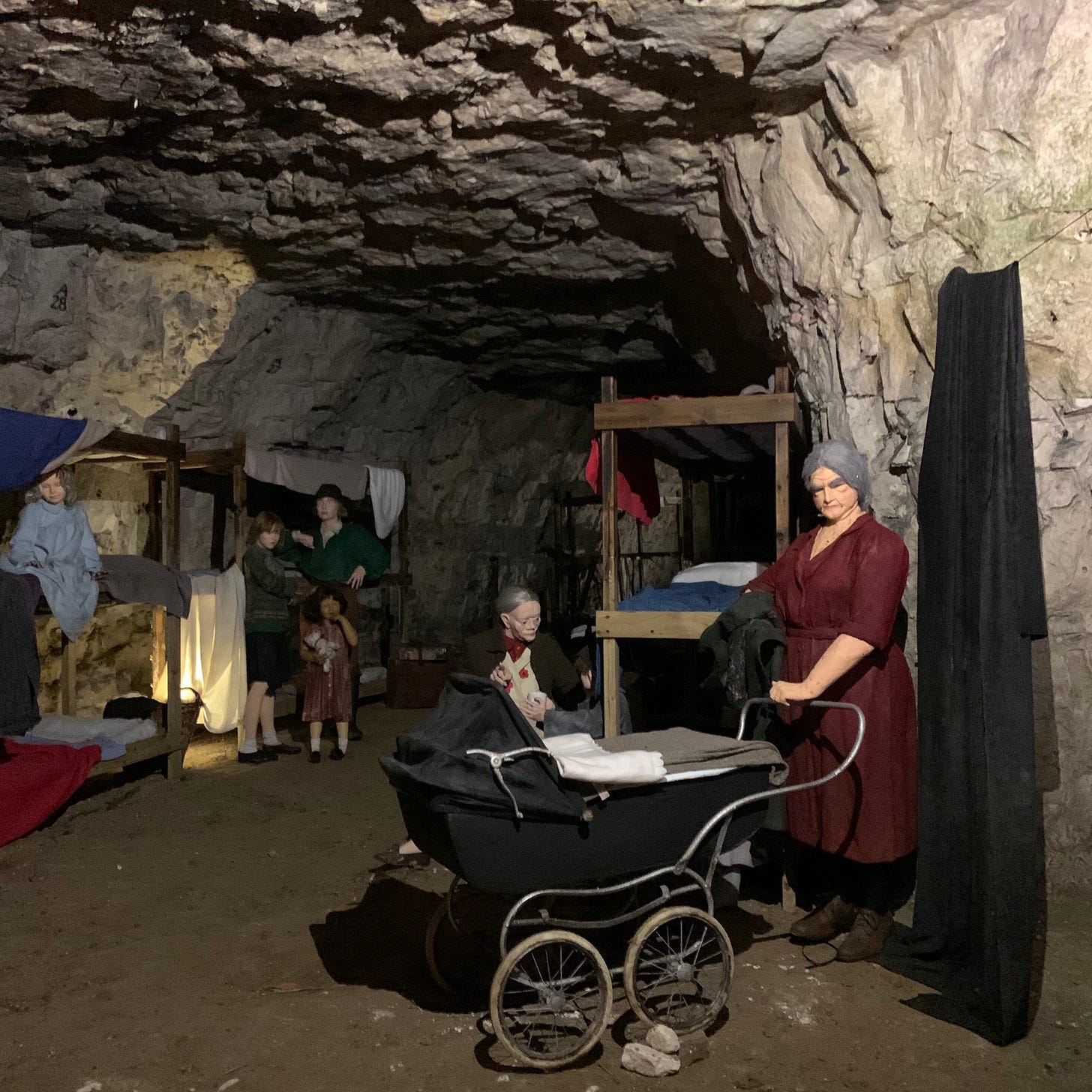Hello and welcome to Wooden City, a newsletter about London.
If you haven’t come here via @caffs_not_cafes, I'm a writer called Isaac Rangaswami and this is my Substack.
Every other week I publish an article about everyday places in London with unusual staying power, like shops, buildings, restaurants and public spaces.
Wooden City is a reader-supported publication and paid subscribers get much more. This includes access to maps, full articles and an archive of material covering over 125 places so far.
It’s a Friday afternoon in Chislehurst and the sky is the colour of cotton wool. The foliage that surrounds the car park is fluttering in the wind, as are everyone’s raincoats. We are milling about in front of a wooden door flanked by a blue plaque and two stone columns, their tops decorated with swirly, classical flourishes. In a moment, the tour will begin.
Our guide to Chislehurst Caves arrives and leads us into a dark and sloping entranceway before handing out the lanterns. He carries a heavy-duty torch himself and is dressed in a parka and a well-worn pair of black Reeboks. As he does the safety run-through, he speaks with the regional accent some people have in this part of Bromley and the bits of Kent into which it bleeds. We follow him down into the caves, holding our only sources of light.
The air is cool and earthy; clouds of water vapour disappear and reappear in front of us as we breathe. The oil lamps are mostly odourless, but the tips of their flames occasionally flicker into black, releasing their distinctive kerosene smell. The tunnels we walk through are broad in the middle and thinner at the top, like an egg sliced widthways. There are lots of little bumps, and sometimes the ground is wet.
Our friendly, dignified guide tells us the things he has told hundreds of others before. Some of his statements are easy to prove, like the fact that these 22 miles of tunnels were created by people mining flint and chalk. Some of them less so, like the idea that Saxons, Romans and human-sacrificing Druids were among those miners, though he’s relatively open about that.
We are also in a subterranean village. Most of its amenities are about 80 years old, because thousands of people spent their nights in these tunnels during the Blitz. The tour revolves around the ordinary things they did: we are shown where they slept, prayed and used the loo each night; we are told how infrequently their waste was taken to the surface; we are informed that their collective body heat created unusually warm temperatures for a cavern.
Many of those people are still down here. Some are children, their painted skin either pockmarked or unnaturally smooth, as if they have aged without getting old. They are posed in creepy positions, costumed in their jumpers, cardigans and long dresses. They are not real, but the names of the people that inspired them are surely among those carved into the chalk.
“Let’s have a bit of fun,” our guide says, as he gathers up our lanterns. He tells us to sit down or hug a wall as he starts walking off, his shadow stretching into the distance. When he turns a corner we are plunged into the blackest possible black, in which closed eyes do as much as open ones. A few crying younger children are comforted by their parents, as our guide’s hidden speakers play the booming sound of Luftwaffe bombs, distant in time and place.
After he comes back with the lanterns, we continue for another 20 minutes or so; before long, the tour is over and we are back where we started. We exit the ramped hallway into a quaint reception building, lined with church pews and photos of the rock bands that performed underground in the 60s and 70s. It is a pleasantly dated place to buy a cup of tea, somewhere between a Laser Quest and a roadside attraction. A petrified boy emerges with his mum not long after us, having quit the next tour just as it began.
I enjoyed my visit to Chislehurst Caves, mainly because they do such a good job of making you forget that it’s a walk through a mineshaft. It’s all very light-hearted, and like many guided tours, it’s the drama and intrigue that bring it to life. The stories, including the ones that are true, could not be told if people hadn’t spent time in these caves.
I think it’s the same with all historical places: the more evidence of human activity they contain, the easier they are to find compelling. When you drive past Stonehenge, somewhere recently brought viscerally into the present, maybe you slow down and look because it’s famous, or because you happen to be there as the sun sinks them into watercolour. But seeing the stones, whether they are covered in orange cornflour or not, doesn’t mean being moved by their history.
You need to know that Stonehenge sits on a Neolithic graveyard, scattered with cremated remains. You need to know that it was already thousands of years old in the Middle Ages, when people thought that Merlin had assembled it with the help of a giant. You need to know that people dressed in animal skins wrenched its multi-ton bluestones from a hill in south-west Wales, then somehow carried them 150 miles, perhaps using sledges or rafts over a waterway, or a combination of both.





